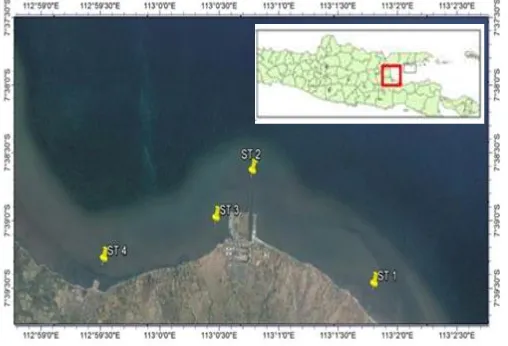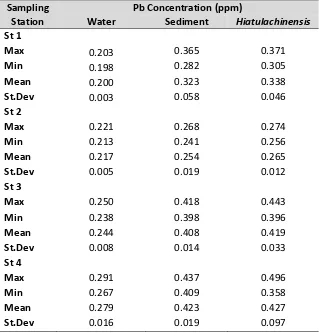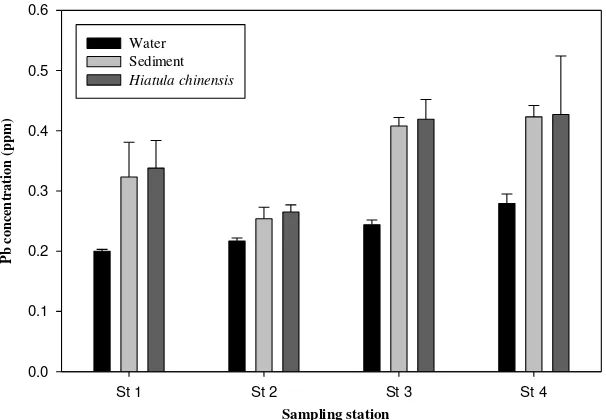Lead (Pb) Accumulation in Water, Sediment and Mussels (
Hiatulachinensis
)
from Pasir Panjang Coast, Lekok-Pasuruan
Defri Yona1, 2), Andira1, and Syarifah Hikmah Julinda Sari1, 2)
1)Marine Science Department, Fisheries and Marine Science Faculty, University of Brawijaya 2)Marine Resources Exploration and Management (MEXMA) Research Group, University of Brawijaya
Email: defri.yona@ub.ac.id
ABSTRACT
This study attempted to evaluate Pb accumulation in the water, sediment and mussels (Hiatulachinensis) from Lekok-Pasuruan. There were four sampling stations representing the study area: (1) urban areas, (2) water flow area from steam power plant (PLTU), (3) waste disposal area of PLTU, (4) fishing port. The average concentration of lead varied between stations in the water (0.279 ppm), sediment (0.423 ppm) and mussels (0.427 ppm). Pearson`s correlation test shows strong relationship (p>0.05) between Pb in the water, sediment and Hiatulachinensis. Mussels accumulation of lead from the sediment was assessed using bio-concentration factor (BCF) and the result shows Hiatulachinensis is an accumulator of Pb (BCF>1).
Keywords: Lead, heavy metal, Hiatulachinensis, Lekok-Pasuruan.
INTRODUCTION
Lead (Pb) is heavy metal that is considered serious threat to water pollution. It is non-essential metal (has no biological function) and even toxic at low concentration. Lead enters the environment mainly from the emission of petrol from the vehicles and from the industrial wastes. Once it accumulates in the sediment, it is easily absorbed by organisms living in the sediment such as mussels.
In many coastal areas, bivalves including mussels Hiatulachinensis (Bouchet, 2015) could be used as bioindicator of pollutants including heavy metals (Belabed et al., 2013).
Most of bivalves are sessile with limited movement ability and tolerant of fluctuations in environmental changes, thus they are subject to heavy metal contamination in their tissues. There are many studies about heavy metals contamination and accumulation in bivalve molluscs (Belabed et. al., 2013; Duarte et. al., 2011; Kwon et. al., 2012; Spada et. al., 2013; Yap et. al., 2016). Heavy metal accumulations in marine organisms occur through the process of bioconcentration or biomagnification. Bioconcentration is the process by which a chemical substance is absorbed by an organism from the environment through respiratory system. On the other hand, biomagnification is the process by which a chemical substance is absorbed by an organism from its diet or food chain (Arnot and Gobas, 2006). Therefore, Hiatulachinensis is vulnerable to the contamination of heavy metal from the environment and also their food. Hiatulachinensis is consumed by many local people. Consuming mussels in long term that contain heavy metals might be dangerous to health.
steam power plant (PLTU), (3) waste disposal area of PLTU, (4) fishing port (Fig. 1).
MATERIALS AND METHODS
This study was conducted in March 2016 at Lekok coastal areas, Pasuruan. Temperature, salinity, pH and Dissolved oxygen (DO) were measured in-situ using Multi Probe Horiba U-50. In each station, about 100 ml surface water sample for Pb analysis was collected in pre-cleaned (acid
washed) polyethylene bottle and added 3-4 drops of nitric acid (HNO3). Water samples
were immediately kept in cool box and transported to the laboratory to avoid contamination. In the laboratory, water samples were filtered using Whatman GF/F membrane filter 0.45 µm and placed in 50 ml beaker glass. The samples were then analyzed its Pb content using Atomic Absorption Spectrophotometer (AAS).
Figure 1. Map of the Four Sampling Stations in Lekok Coastal Areas, Pasuruan.
Surface sediment samples at ± 5 cm were collected by hand and placed in clean polyethylene bottle. The samples were stored in frozen condition for further analysis. Sediment samples were dried in oven at 80˚C for 48 h. Dried sediment samples were then crushed to the finest possible fraction using an acid-washed pestle and mortar. About 2 g of the sample was digested at room temperature in a beaker with 10 ml of 70% reagent grade nitric acid for an overnight. The digested samples were then analysed using a flame Atomic Absorption Spectrophotometer (AAS).
A total of 10 mussels Hiatulachinensis were collected for each station and rinsed with sea water to clean it from the mud. Cleaned mussel samples were placed in
plastic bag, properly packed and immediately put into cool box. In laboratory, mussel samples were dried at 80˚C for 48 h and homogenized with a mixer. Samples were then weighed and placed in Furnace oven at 450˚C for 12 h. Pb in the digested samples were determined by AAS.
mussels Hiatulachinensis were tested using Pearson`s correlation analysis.
RESULTS AND DISCUSSION
Hydrographic condition of the study area is shown at Table 1. The average values of temperature, salinity, pH and dissolve oxygen were not very different among
stations. Temperature was in the range of 32.06-33.71º C, salinity was found between 31.64-33.97 psu, pH was 7.45˗8.51 and dissolved oxygen was 6.85˗7.31 mg/l. The physico-chemical parameters were still in the range of normal condition for marine environment.
Table 1. Mean (± SD) of the Environmental Data
Sampling station
Temperature (o C)
Salinity
(psu) pH
Dissolved Oxygen (mg/l)
St 1 33.35 ± 0.50 32.80 ± 1.64 7.9 ± 0.64 6.97 ± 0.08
St 2 32.11 ± 007 33.08 ± 0.33 7.8 ± 0.53 7.21 ± 0.13
St 3 32.63 ± 0.32 33.08 ± 0.29 8.1 ± 0.41 7.04 ± 0.26
St 4 33.59 ± 0.94 32.95 ± 1.27 8.3 ± 0.24 6.58 ± 0.56
Pb concentration showed significant increasing values from the water to the sediment and the mussels Hiatulachinensis (Fig. 2). The concentrations were found in similar range between the sediment and the mussels but the concentration in the water was lower compared to those two. Pb concentration in the water was in the range of 0.198˗0.291 ppm; in the sediment 0.241˗0.437 ppm and in the mussels Hiatulachinensis 0.256-0.496 ppm (Table 2). Pb concentrations in this study were higher compared to concentrations in another study both in water and sediment. Sugiyanto (2016a) in her study in Paciran, Lamongan found Pb concentrations in the water were in the range of 0.035˗0.276 ppm and in the sediment 0.108˗0.261 ppm. However, the results of this study were lower compared to the study conducted in the coastal areas of Probolinggo with Pb concentration in the water was in the range of 0.140-0.521 ppm and in the sediment 0.273-0.509 ppm (Sugiyanto, 2016b). The difference in Pb concentrations was the result of many factors such as source input of Pb to the environment and also characteristics of the
environmental factors (temperature and salinity).
Pb concentration in the sediment is related to the concentration in the water and it is supported with the result of Pearson`s correlation test (r2=0.755, p<0.05). Higher
Table 2. Pb Concentration (ppm) in the Water, Sediment and Mussels Hiatulachinensis
Sampling Station
Pb Concentration (ppm)
Water Sediment Hiatulachinensis
St 1
Max 0.203 0.365 0.371
Min 0.198 0.282 0.305
Mean 0.200 0.323 0.338
St.Dev 0.003 0.058 0.046
St 2
Max 0.221 0.268 0.274
Min 0.213 0.241 0.256
Mean 0.217 0.254 0.265
St.Dev 0.005 0.019 0.012
St 3
Max 0.250 0.418 0.443
Min 0.238 0.398 0.396
Mean 0.244 0.408 0.419
St.Dev 0.008 0.014 0.033
St 4
Max 0.291 0.437 0.496
Min 0.267 0.409 0.358
Mean 0.279 0.423 0.427
St.Dev 0.016 0.019 0.097
The steam power plant is also contributed to the input of Pb to the environment either directly to the water system or to the air. In this study, significant impact of the power plant can be seen at Stations 2 and 3. Based on the International Finance Corporation (2008), the effluent of Pb from the power plant should not exceeded 0.5 mg/L. Thus, Pb concentration in this study area which received influence from the power plant was still in the permissible limit.
Hiatulachinensis is benthic organism live in the sediment and the rate of their accumulation of heavy metals is in proportion with the rate of water and sediment contamination. Higher accumulation of Pb in Stations 3 and 4 compared to the accumulation in Stations 1 and 2 were due to
Sampling station
St 1 St 2 St 3 St 4
P
b
c
o
n
ce
n
tr
a
tion
(
p
p
m
)
0.0 0.1 0.2 0.3 0.4 0.5 0.6
Water Sediment Hiatula chinensis
Figure 2. The Average concentration of Pb (ppm) in the Water, Sediment and Mussels Hiatulachinensis in
Lekok-Pasuruan.
Pb concentration in this study was observed to be very much higher than the acceptable level (0.05 mg/l) for the seawater quality set by the Indonesian Ministry of Environment (2004). Furthermore, Pb concentration in the mussels Hiatulachinensis was also found to be very much higher than the permissible limit set by both the Indonesian Ministry of Environment (2004) for marine organism (0.008 mg/l) and the Indonesian National Standards Authority (2009) for seafood consumption safety level (0.3 mg/kg). Therefore, the consumption of mussel Hiatulachinensis needs to be taken caution in order to prevent dangerous health issues especially for local people.
Table 3. Bioconcentration Factor of Mussels Hiatulachinensis in the Study Area.
Sampling station Bioconcentration factor
St 1 1.046
St 2 1.039
St 3 1.026
St 4 1.009
Average 1.028
CONCLUSION
Pb is one of the heavy metals that is considered dangerous pollutant because its toxicity even at low concentration. The accumulations of Pb in the environment and also in the mussels are related with the metal source from the urban and industrial activities.
mussel Hiatulachinensis that is consumed by local people.
REFERENCES
Arnot, J., Gobas, F. (2006). A review of bioconcentration factor (BCF) and bioaccumulation factor (BAF) assessments for organic chemicals in aquatic organisms. Environ. Rev. 14, 257–297.
Baltas, H., Dalgic, G., Bayrak, E. Y., Sirin, M., Cevik, U., Apaydin, G. (2016). Experimental study on copper uptake capacity in the Mediterranean mussel (Mytilus galloprovincialis). Environ. Sci. Pollut. Res. 23, 10983–10989. doi:10.1007/s11356-016-6306-0
Belabed, B. -E., Laffray, X., Dhib, A., Fertouna-Belakhal, M., Turki, S., Aleya, L. (2013). Factors contributing to heavy metal accumulation in sediments and in the intertidal mussel Perna perna in the Gulf of Annaba (Algeria). Mar. Pollut. Bull. 74,
477–489. doi:10.1016/
j.marpolbul.2013.06.004.
Bouchet, P. (2015). Hiatula chinensis (Morch, 1853). Mollusca Base 2015.
Duarte, C. A., Giarratano, E., Amin, O. A., Comoglio, L. I. (2011). Heavy metal concentrations and biomarkers of oxidative stress in native mussels (Mytilus edulis chilensis) from Beagle Channel coast (Tierra del Fuego, Argentina). Mar. Pollut. Bull. 62, 1895– 1904.
doi:10.1016/j.marpolbul.2011.05.031 Indonesian Ministry of Environment. (2004).
Seawater standard quality (No. 51). Indonesian National Standards Authority.
(2009). Food safety level of heavy metals content (No. SNI 7387).
International Finance Corporation. (2008). Environmental, health and safety guidelines for thermal power plants.
Kumar, V., Sinha, A. K., Rodrigues, P. P., Mubiana, V. K., Blust, R., De Boeck, G. (2015). Linking environmental heavy metal concentrations and salinity gradients with metal accumulation and their effects: A case study in 3 mussel Characterizing the effect of heavy metal contamination on marine mussels using metabolomics. Mar. Pollut. Bull. 64, 1874–1879.
doi:10.1016/j.marpolbul.2012.06.012 Spada, L., Annicchiarico, C., Cardellicchio, N.,
Giandomenico, S., Di Leo, A. (2013). Heavy metals monitoring in mussels Mytilus galloprovincialis from the Apulian coasts (Southern Italy).
Mediterr. Mar. Sci. 14.
doi:10.12681/mms.323
Sugiyanto, R. A. (2016a). Analisis akumulasi timbal (Pb) dan kadmium (Cd) pada lamun Enhalus acoroides sebagai agen fitoremediasi di Pantai Paciran, Lamongan. Universitas Brawijaya, Malang, Indonesia.
Sugiyanto, R. A. (2016b). Analisis akumulasi akar mangrove Rizophora mucronata dan Avicennia marina terhadap logam berat Pb dan Cu di Pesisir Kota Probolinggo, Jawa Timur. Universitas Brawijaya, Malang, Indonesia.



